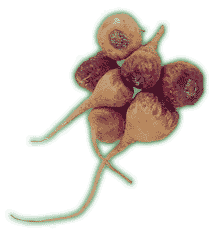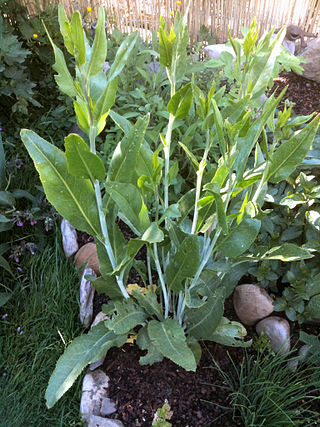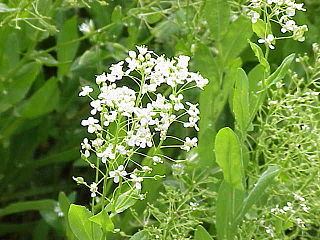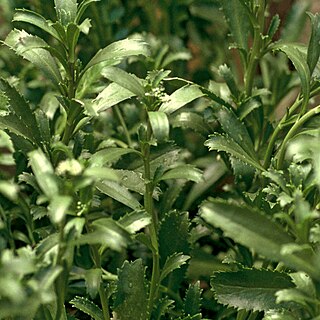
Lepidium meyenii, known as maca or Peruvian ginseng, is an edible herbaceous biennial plant of the family Brassicaceae that is native to South America in the high Andes mountains of Peru and Bolivia. It was rediscovered for commercial purposes at the Meseta de Bombón plateau close to Lake Junin in the late 1980s. It is grown for its fleshy hypocotyl that is fused with a taproot, which is typically dried but may also be freshly cooked as a root vegetable. As a cash crop, it is primarily exported as a powder that may be raw or processed further as a gelatinized starch or as an extract. If dried, it may be processed into a flour for baking or as a dietary supplement.

Lepidium latifolium, known by several common names including perennial pepperweed, broadleaved pepperweed, pepperwort, or peppergrass, dittander, dittany, and tall whitetop, is a perennial plant that is a member of the mustard and cabbage family.

Lepidium is a genus of plants in the mustard/cabbage family, Brassicaceae. The genus is widely distributed in the Americas, Africa, Asia, Europe, and Australia. It includes familiar species such as garden cress, maca, and dittander. General common names include peppercress, peppergrass, pepperweed, and pepperwort. Some species form tumbleweeds. The genus name Lepidium is a Greek word meaning 'small scale', which is thought to be derived from a folk medicine usage of the plant to treat leprosy, which cause small scales on the skin. Another meaning is related to the small scale-like fruit.

Lepidium virginicum, also known as least pepperwort or Virginia pepperweed, is an herbaceous plant in the mustard family (Brassicaceae). It is native to much of North America, including most of the United States and Mexico and southern regions of Canada, as well as most of Central America. It can be found elsewhere as an introduced species.

Lepidium draba, also known as whitetop, hoary cress, or Thanet cress, is a rhizomatous perennial flowering plant in the family Brassicaceae. It is native to western Asia and southeastern Europe and has been widely introduced elsewhere.

Coronopus is a synonym for the accepted genus name Lepidium. It was applied to some species of flowering plants in the cabbage and mustard family Brassicaceae known commonly as swinecress or wartcress. These are generally low spreading annual herbaceous plants with many long stems, deeply lobed leaves and small white flowers. They have a strong scent, smelling like garden cress, Lepidium sativum, when crushed. Lepidium squamatus may be native to the Mediterranean but Lepidium didymum may be native to South America. Both species are widespread weedy introduced species in other areas.

Lepidium densiflorum is a species of flowering plant in the mustard family known by the common names common pepperweed, prairie peppergrass, elongate peppergrass, hairy-fruited peppergrass, and large-fruited peppergrass.

Lepidium flavum is a species of flowering plant in the mustard family known by the common name yellow pepperweed. It is native to California, Nevada, and Baja California, where it grows in the Sonoran and Mojave Deserts. The species epithet flavum is Latin for yellow and indicates its flower colour.

Lepidium montanum is a species of flowering plant in the mustard family known by the common names mountain pepperweed, mountain peppergrass, mountain pepperwort, and mountain pepperplant. It is native to western North America from Oregon to Montana to northern Mexico, where it can be found in a number of habitats, often on salty or gravelly soils. There are several varieties, many of which are difficult to distinguish.
Lepidium oxycarpum is a species of flowering plant in the mustard family known by the common names forked pepperweed and sharp-fruited pepperweed.

Lepidium perfoliatum is a species of flowering plant in the mustard family known by the common names clasping pepperweed and perfoliate pepperwort. It is native to Europe and Asia and it can be found in other parts of the world as an introduced species.

Artemisia arbuscula is a North American species of sagebrush known by the common names little sagebrush, low sagebrush, or black sagebrush. It is native to the western United States from Washington, Oregon, and California east as far as Colorado and Wyoming. It grows in open, exposed habitat on dry, sterile soils high in rock and clay content.

Lepidium dictyotum is a species of flowering plant in the mustard family known by the common names alkali pepperweed and alkali pepperwort.
Lepidium pinnatifidum is a species of flowering plant in the mustard family known in English by the common name featherleaf pepperweed.

Silene perlmanii is a rare species of flowering plant in the family Caryophyllaceae known by the common name cliff-face catchfly. It is endemic to Hawaii, where it is known only from the southern Waianae Mountains of Oahu. Today there are no plants left in the wild. The species is in cultivation at the National Tropical Botanical Garden. It is a federally listed endangered species of the United States.

Lepidium banksii, known as coastal peppercress, is a rare species of flowering plant from the family Brassicaceae. It is endemic to New Zealand, formerly found around the coast of the northern South Island but now critically endangered.

Lepidium heterophyllum is a species of flowering plant in the mustard family which is native to parts of western Europe, growing in shingle banks, wasteland or cultivated fields.

Lepidium foliosum, commonly known as leafy peppercress, is a shrubby species of plant found in southern regions of Australia, usually close to the coast. The herbaceous species is shrubby in form, with hairless leaves and stem, and resembles others plants of the mustard family Brassicaceae.
















